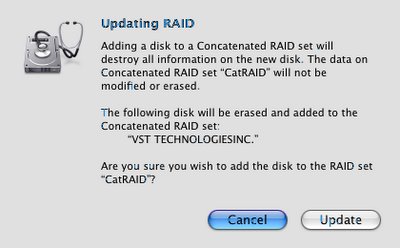So, our primary authentication server, which will be used to enable network home accounts for our entire internal network — Mac, Windows and Linux — is up and running. I've installed it in our server room, put it on the KVM, and switched over all the workstations. So far, so good. (My fingers are so crossed they hurt.)
For the Windows quota requirements we went with the first solution mentioned in this article, and outlined in detail here: Windows roaming profiles are on a separate, quota-enabled volume on the authentication server. This — and the Windows implementation in general — is my biggest concern, and will require a great deal of testing. Summer Session has begun, and this will give us the opportunity to test on live subjects as a limited pool of students begins using the systems for work again.
There are a couple of immediate benefits of this new system. For one, users can now change their password lab-wide from any Mac in the lab. Now, users don't tend to do this much, but they can if they want to, and it's easy as pie. But as an admin, the most exciting benefit to all this is the ease with which new users can now be created. In the past, creating a new user was a multi-step, multi-computer process that involved coordination between multiple sysadmins: Admin 1 gets the user info, creates the Linux and Windows accounts and hands it off to admin 2, who then creates the Mac account and uploads the Mac skel. This process was lengthy and extremely error-prone. Using the new system, user creation is a breeze. One single, easy-to-use script on the authentication server pretty much does it all. Any sysadmin — or even a trained assistant — can do it. Just log in to the authentication server, run the script, and you're basically done. It's fast, easy and accurate. Which is really the whole reason we're doing all this. I'm pretty happy about it.
There are a few minor details I need to work out. The main one is file sharing. In addition to being an authentication server, our original Mac server is also a file server. On it there are numerous shares for various purposes — one for staff, one for students, etc.. At this point I'm thinking of keeping the file server and the authentication server separate. This will reduce the load on both, and mitigate the need to migrate any data. The catch is that user authentication data on the file server will need to match that of the new authentication server. This should be a simple matter of changing the old server's role to "Connected to a Directory System" and pointing it at the new authentication server. I've never done this though, and it's complicated by the fact that the old server is running Panther whereas the new one is running Tiger. Probably the best thing to do will be to wipe the old server (yes, I have a backup) and put Tiger on it, then redo the shares. But I'll probably test with Panther first, just to see what happens. I'll let you know.
In any case, this is, again, a minor problem that shouldn't affect the overall plan much and should be relatively easy to figure out and implement. It's just one of those little things you forget about when you're drawing up your master plan for world conquest. "Oh yeah... What about the file server?..."
Otherwise, the conversion is on and seems to be going smoothly so far. Once we get into serious testing I'll post the results. Hopefully this will all be done in the next few weeks and the conversion will finally be complete.







